The Close Relationship between Internal Wave and Ocean Free Surface Wave
Abstract
:1. Introduction
2. Numerical Method
2.1. Fluent Simulation Method
2.2. Artificial Neural Network (ANN)
3. Results and Discussion
3.1. IW Propagation
3.2. Correlation between the Simulated and ANN Predicted IWs
IW Prediction by Free Surface Wave Signals
3.3. Linear Internal Wave Theory
3.3.1. Linear Wave Theory I: (Archimedes Principle)
3.3.2. Linear Wave Theory II: (Depth Effects Included)
3.4. The Layers Thickness Prediction
4. Conclusions
- (1)
- The simulated data were used to train an ANN model which was used to predict the IWs profile by the free surface displacement. The comparisons of three different depression IWs propagation cases show that the predicted data agrees very well with the simulated data, especially in the time period of main IW passes Probe-1, and minor difference occurs when the trailing waves pass. Similar behaviors were found in the elevation IWs propagation cases.
- (2)
- The comparison of ANN-predicted IWs and those predicted by linear IW theory was also made. The hindcasting quality of ANN-predicted IWs are very good, whereas the prediction made by the linear IW theory without depth effect can only give correct trend of the interfacial displacement. The prediction accuracy is poor, and the arrival time lag is also found in the prediction of linear wave theory I. As the depth effects were considered, the prediction quality of the linear wave theory became better, especially in depression IWs prediction.
- (3)
- The simple formulae are given for layer thickness ratio prediction. We may use simulated free surface displacement to predict the interfacial displacement and calculate the ratio of both displacements and use the regression equations to determine the layers thickness ratio, and the upper and lower layer thicknesses can then be obtained.
- (4)
- In addition, the relationships between free surface displacement and layers thickness ratio are also determined. The observed maximum peak and minimum trough displacements of the free surface wave can be used to calculate the layers thickness ratio, and the depths of the upper and lower water layers can be easily determined.
- (5)
- Using the free surface wave signal observed by a remote buoy, the proposed ANN model is applicable and can successfully predict the spatial variation of the internal wave. Thus, the proposed simple method may help researchers to infer the amplitude of IW from remote surface wave signatures. In the future, the spatial distribution of IW below the sea surface might be obtained by the proposed method without costly field investigation.
Author Contributions
Funding
Institutional Review Board Statement
Informed Consent Statement
Conflicts of Interest
References
- Thrope, S.A. The excitation, dissipation, and interaction of internal waves in the deep ocean. J. Geophys. Res. 1975, 80, 328–338. [Google Scholar] [CrossRef]
- Cairns, J.L.; Williams, G.O. Internal wave observations from a midwater float, 2. J. Geophys. Res. 1976, 81, 1943–1950. [Google Scholar] [CrossRef]
- Farmer, D.M. Observation of long nonlinear internal waves in a lake. J. Phys. Oceanogr. 1978, 8, 63–73. [Google Scholar] [CrossRef] [Green Version]
- Osborne, A.R.; Burch, T.L. Internal solitons in the Andaman Sea. Science 1980, 208, 451–460. [Google Scholar] [CrossRef]
- Ebbesmeyer, C.C.; Romea, R.D. Final Design Parameters for Solitons at Selected Locations in South China Sea; Final and Supplementary Reports Prepared for Amoco Production Company: Houston, TX, USA, 1992; 209p. [Google Scholar]
- Benjamin, T.B. Internal waves of finite amplitude and permanent form. J. Fluid Mech. 1966, 25, 241–270. [Google Scholar] [CrossRef] [Green Version]
- Benjamin, T.B. Internal waves of permanent form in fluids of great depth. J. Fluid Mech. 1967, 29, 559–592. [Google Scholar] [CrossRef]
- Ono, H. Algebraic solitary waves in stratified fluid. J. Phys. Soc. Jpn. 1975, 39, 1082–1091. [Google Scholar] [CrossRef]
- Koop, C.G.; Butler, G. An investigation of internal solitary waves in a two-fluid system. J. Fluid Mech. 1981, 112, 225–251. [Google Scholar] [CrossRef]
- Muller, P.; Liu, X. Scattering of internal waves at finite topography in two dimensions. Part I: Theory and case studies. J. Phys. Oceanogr. 2000, 30, 532–549. [Google Scholar] [CrossRef]
- Vlasenko, V.; Hutter, K. Numerical experiments on the breaking of solitary internal waves over a slope-shelf topography. J. Phys. Oceanogr. 2002, 32, 1779–1793. [Google Scholar] [CrossRef]
- Grimshaw, R.; Pelinovsky, E.; Taipova, T. Rogue internal waves in the ocean: Long wave model. Eur. Phys. J. Spec. Top. 2010, 185, 195–208. [Google Scholar] [CrossRef]
- Nycander, J. Generation of internal waves in the deep ocean by tides. J. Geophys. Res. 2005, 110, C10028. [Google Scholar] [CrossRef] [Green Version]
- Álvarez, Ó.; González, C.J.; Mañanes, R.; López, L.; Bruno, M.; Izquierdo, A.; Gómez-Enri, J.; Forero, M. Analysis of short-period internal waves using wave-induced surface displacement: A three-dimensional model approach in Algeciras Bay and the Strait of Gibraltar. J. Geophys. Res. 2011, 116, C12033. [Google Scholar] [CrossRef] [Green Version]
- Epifanova, A.S.; Rybin, A.V.; Moiseenko, T.E.; Kurkina, O.E.; Kurkin, A.A.; Tyugin, D.Y. Database of Observations of the Internal Waves in the World Ocean. Phys. Oceanogr. 2019, 26, 350–356. [Google Scholar] [CrossRef] [Green Version]
- Noh, S.; Nam, S. Observations of enhanced internal waves in an area of strong mesoscale variability in the southwestern East Sea (Japan Sea). Sci. Rep. 2020, 10, 9068. [Google Scholar] [CrossRef]
- NASA. Earth Sciences and Image Analysis Laboratory. Date Acquired: 24 January 2020, Courtesy of NASA. Available online: https://www.jpl.nasa.gov/spaceimages/details.php?id=PIA01915 (accessed on 24 January 2020).
- Hajji, H.; Sole, S.; Ramamonjiarisoa, A. Analysis and Prediction of Internal Waves Using SAR Image and Non-Linear Model. In Proceedings of the a SAR Workshop: CEOS Committee on Earth Observation Satellites, Working Group on Calibration and Validation, Toulouse, France, 26–29 October 1999. [Google Scholar]
- Kropfli, R.A.; Ostrovski, L.A.; Stanton, T.P.; Skirta, E.A.; Keane, A.N.; Irisov, V. Relationships between strong internal waves in the coastal zone and their radar and radiometric signatures. J. Geophy. Res. 1999, 104, 3133–3148. [Google Scholar] [CrossRef]
- Hong, D.-B.; Yang, C.-S.; Kim, T.-H.; Ouchi, K. Analysis of internal waves around the Korean Peninsula using RADARSAT-1 data. In Proceedings of the SPIE 9240, Remote Sensing of the Ocean, Sea Ice, Coastal Waters, and Large Water Regions 2014, Amsterdam, The Netherlands, 22–25 September 2014. [Google Scholar] [CrossRef]
- Chen, B.-F.; Huang, Y.-J.; Chen, B.; Tsai, S.-Y. Surface wave disturbance during internal wave propagation over various types of sea bottoms. Ocean. Eng. 2016, 125, 214–225. [Google Scholar] [CrossRef]
- Hirt, C.W.; Nichols, B.D. Volume of fluid (VOF) method for the dynamics of free boundaries. J. Comput. Phys. 1981, 39, 201–225. [Google Scholar] [CrossRef]
- Leonard, B.P. A stable and accurate convective modelling procedure based on quadratic upstream interpolation. Comput. Methods Appl. Mech. Eng. 1979, 19, 59–98. [Google Scholar] [CrossRef]
- Issa, R.I. Solution of the implicitly discretised fluid flow equations by operator-splitting. J. Comput. Phys. 1986, 62, 40–65. [Google Scholar] [CrossRef]
- Hsieh, C.M.; Hwang, R.R.; Hsu, J.R.C.; Cheng, M.H. Numerical modeling of flow evolution for an internal solitary wave propagating over a submerded ridge. Wave Motion 2015, 55, 48–72. [Google Scholar] [CrossRef]
- Fu, K.S. The Effect of Nonlinearity and Mixed Layer Thickness on the Propagation of Nonlinear Internal Waves. Master’s Thesis, Institute Physical Oceanography, National Sun Yat-sen University, Kaohsiung, Taiwan, 2007. (In Chinese). [Google Scholar]
- Kuo, C.F. The Experimental Study of IW Pass an Obstacle. Master’s Thesis, Institute of Institute Physical Oceanography, National Sun Yat-sen University, Kaohsiung, Taiwan, 2005. (In Chinese). [Google Scholar]
- Chen, S.H. The Experimental Study of IW over a Slope Sea Bed. Master’s Thesis, Department of Marine Environment and Engineering, National Sun Yat-sen University, Kaohsiung, Taiwan, 2004. (In Chinese). [Google Scholar]
- Malekmohamadia, I.; Ghiassia, R.; Yazdanpanahb, M.J. Wave hindcasting by coupling numerical model and artificial neural networks. Ocean. Eng. 2008, 35, 417–425. [Google Scholar] [CrossRef]
- Chen, B.F.; Wang, H.D.; Chu, C.C. Wavelet and artificial neural network analyses of tide forecasting and supplement of tides around Taiwan and South China Sea. Ocean. Eng. 2007, 34, 2161–2175. [Google Scholar] [CrossRef]
- Maxworthy, T. A note on the internal solitary waves produced by tidal flow over a three-dimensional ridge. J. Geophys. Res. 1979, 84, 338–346. [Google Scholar] [CrossRef]
- Shao, W.; Zhang, Z.; Li, X.; Li, H. Ocean Wave Parameters Retrieval from Sentinel-1 SAR Imagery. Remote Sens. 2016, 8, 707. [Google Scholar] [CrossRef] [Green Version]
- Magic Lectures on Nonlinear Waves. Available online: http://www.maths.dept.shef.ac.uk/magic/course.php?id=21 (accessed on 24 January 2020).


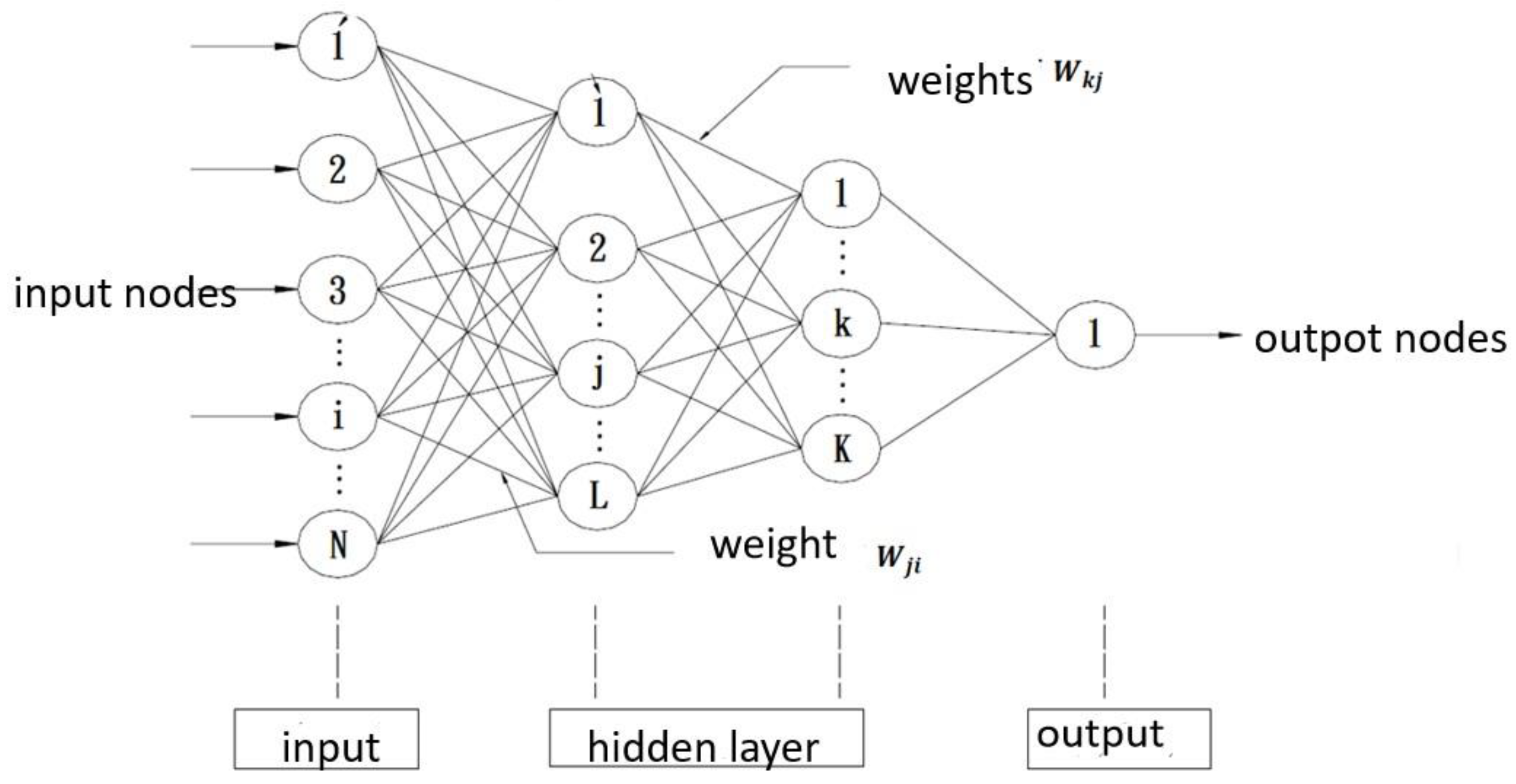

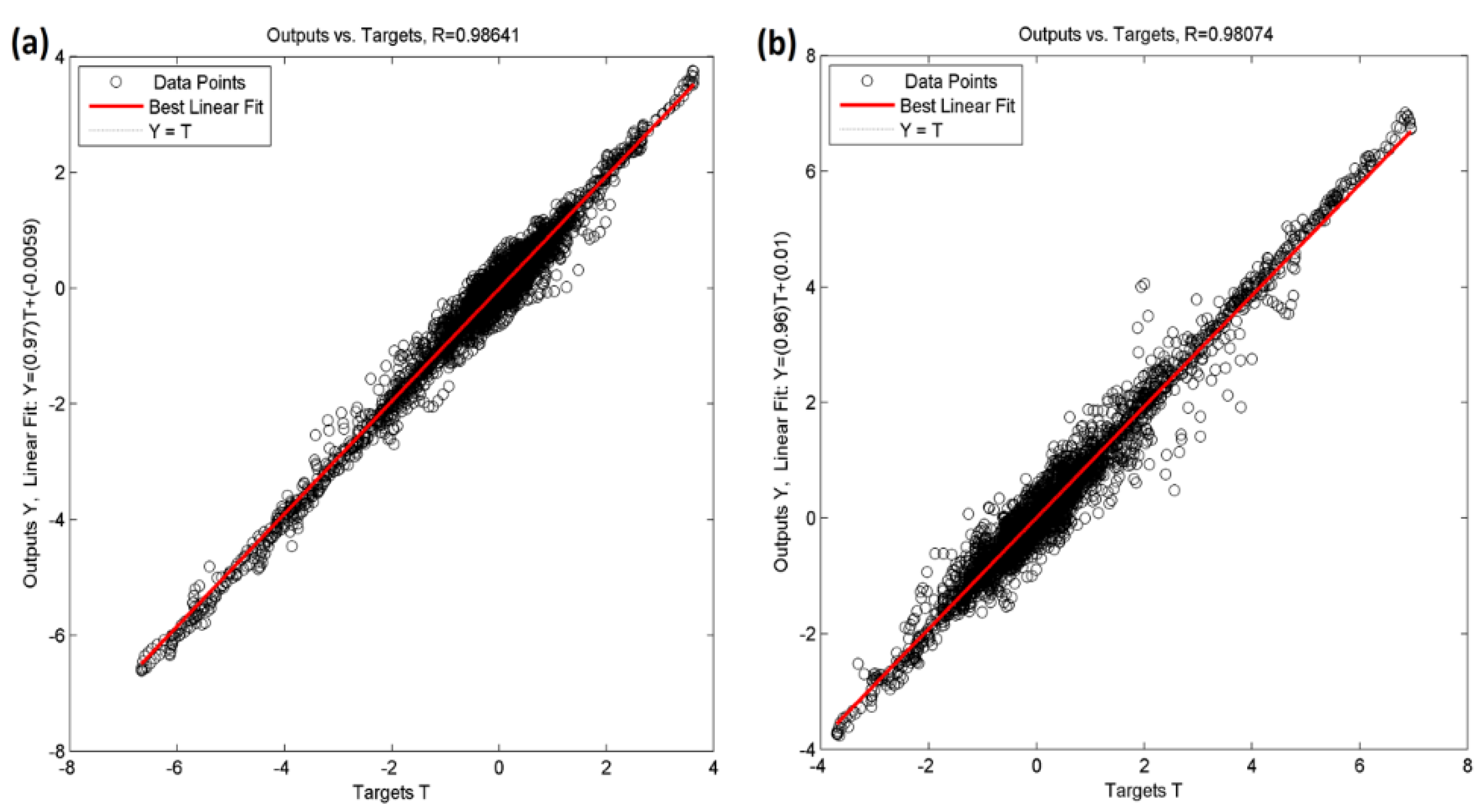
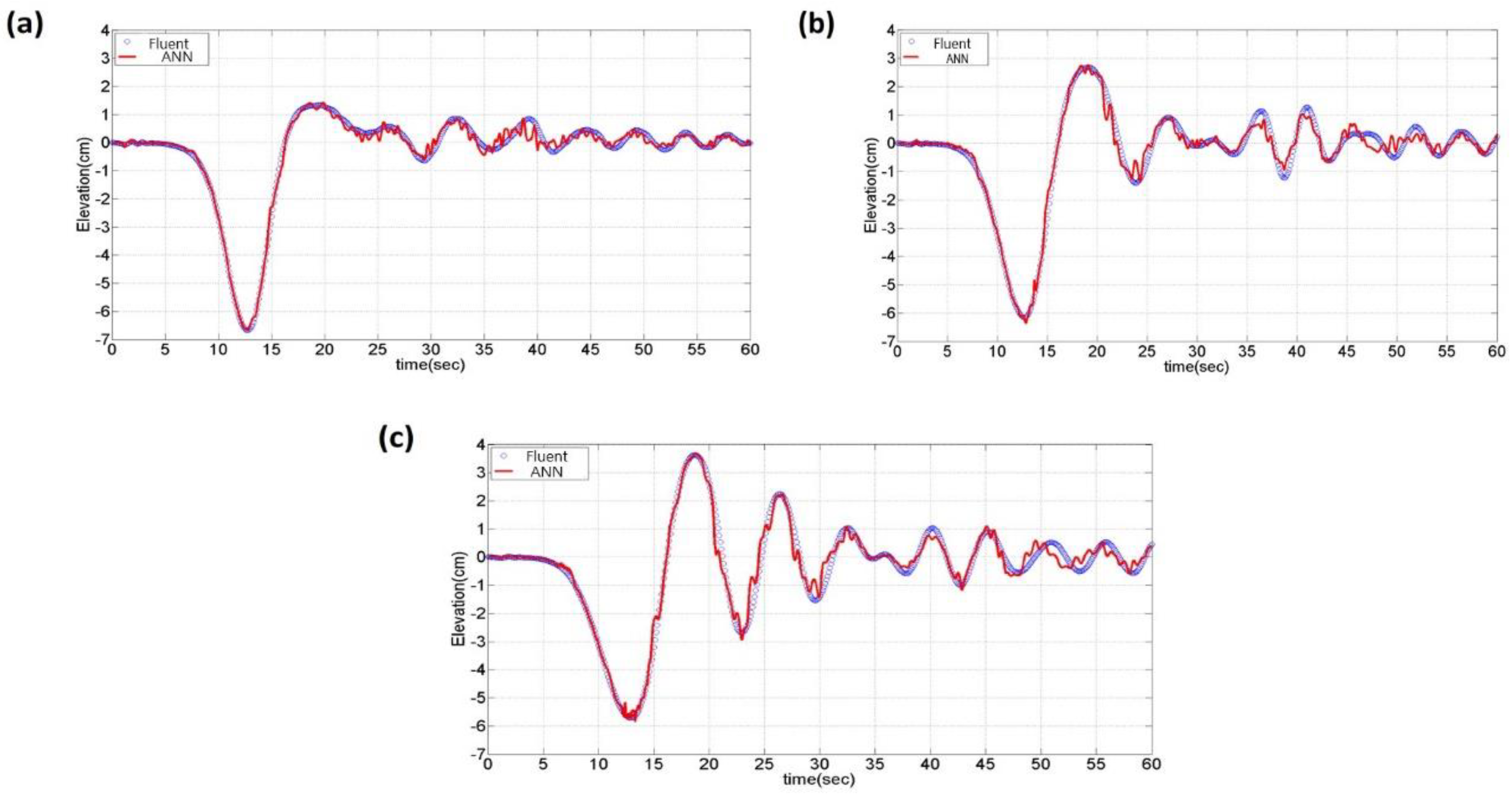
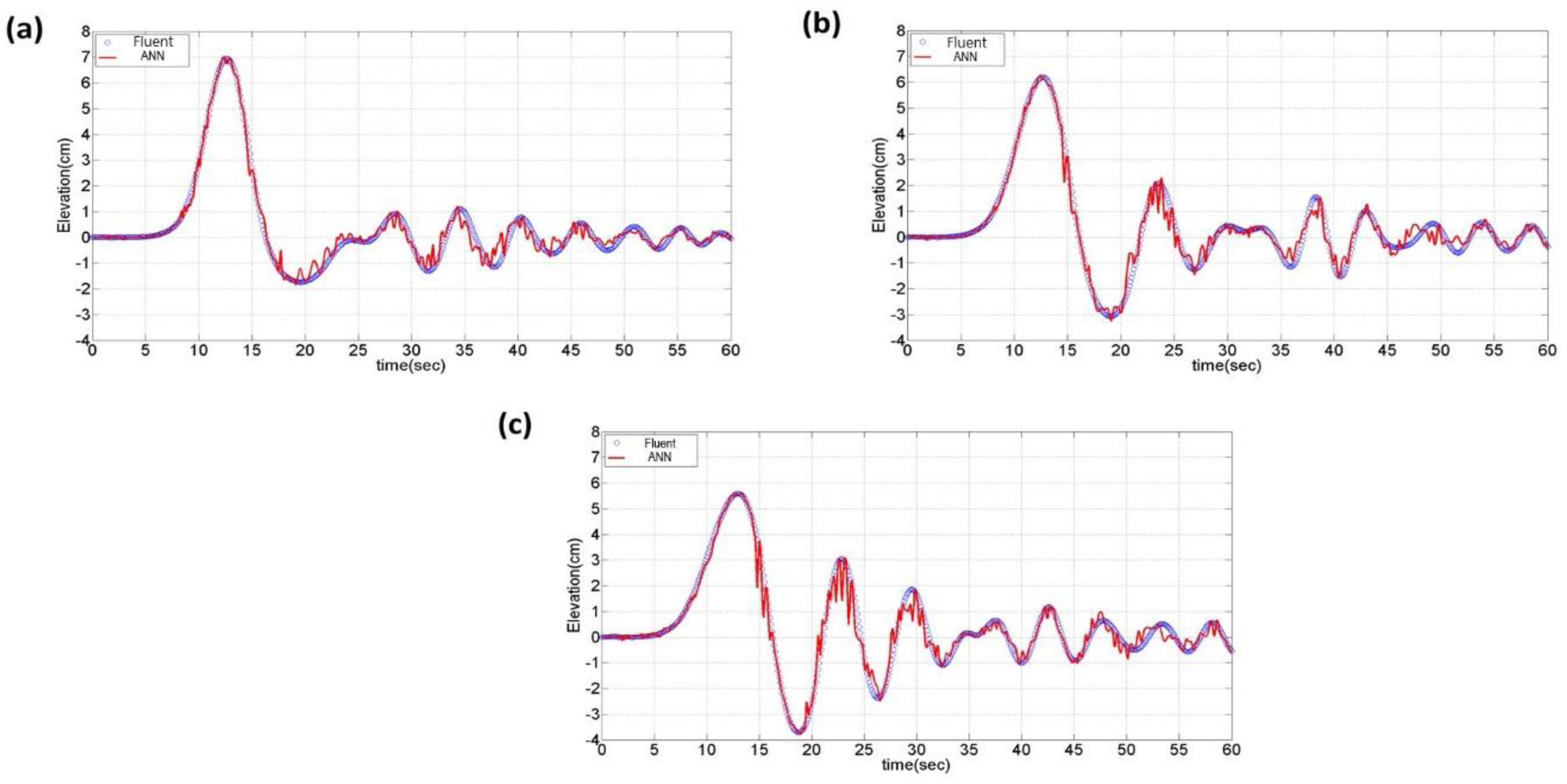
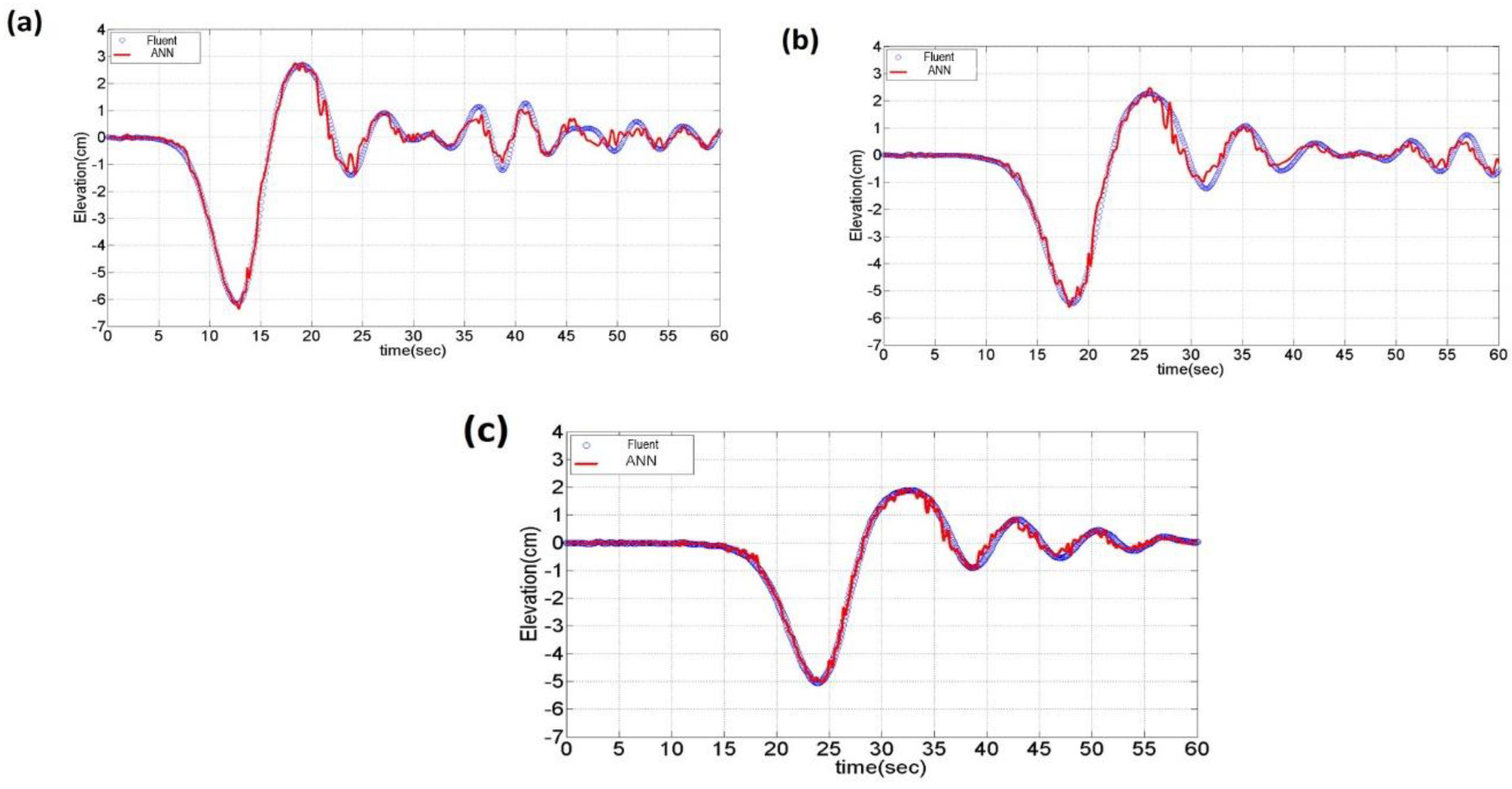
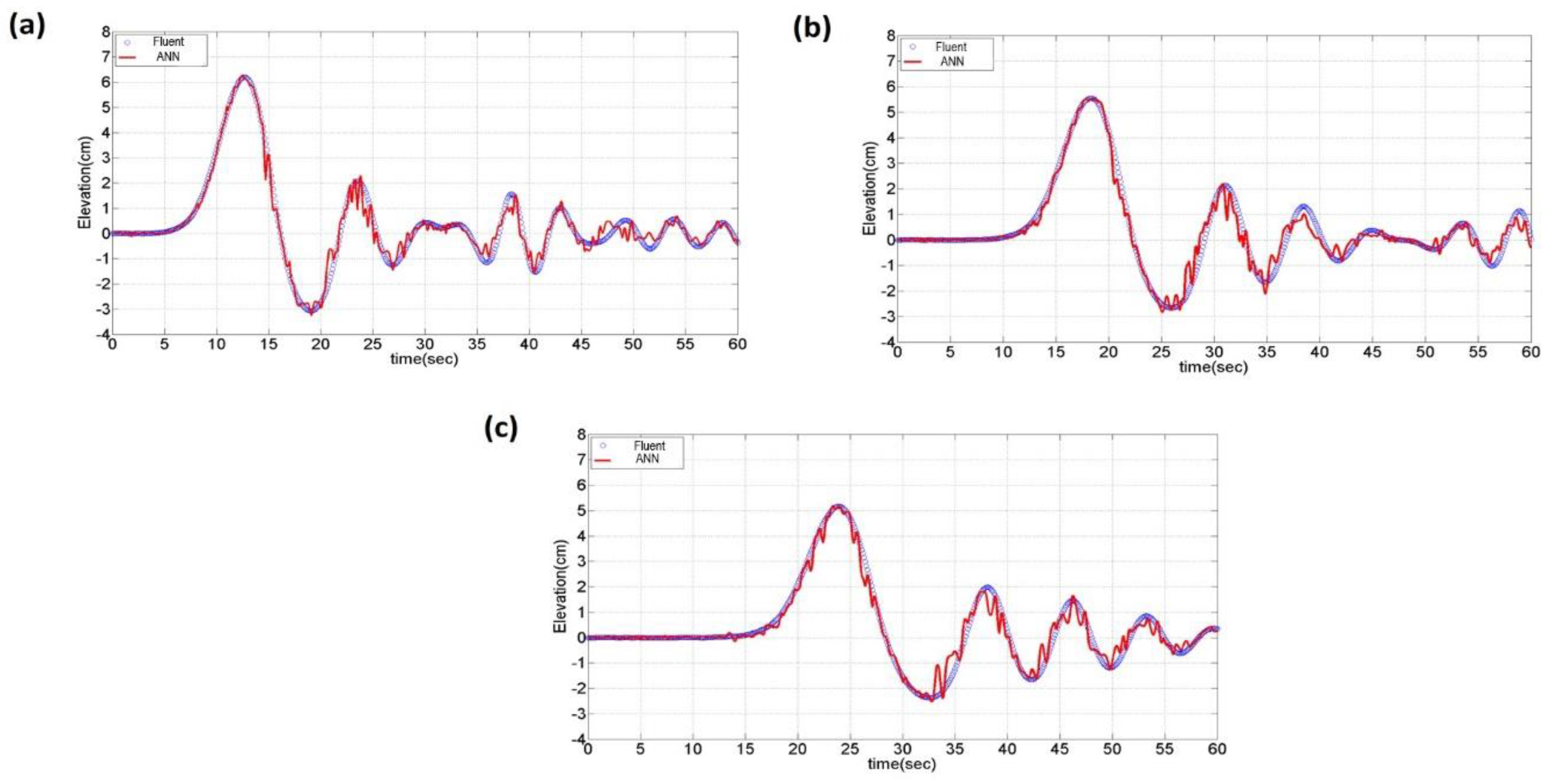

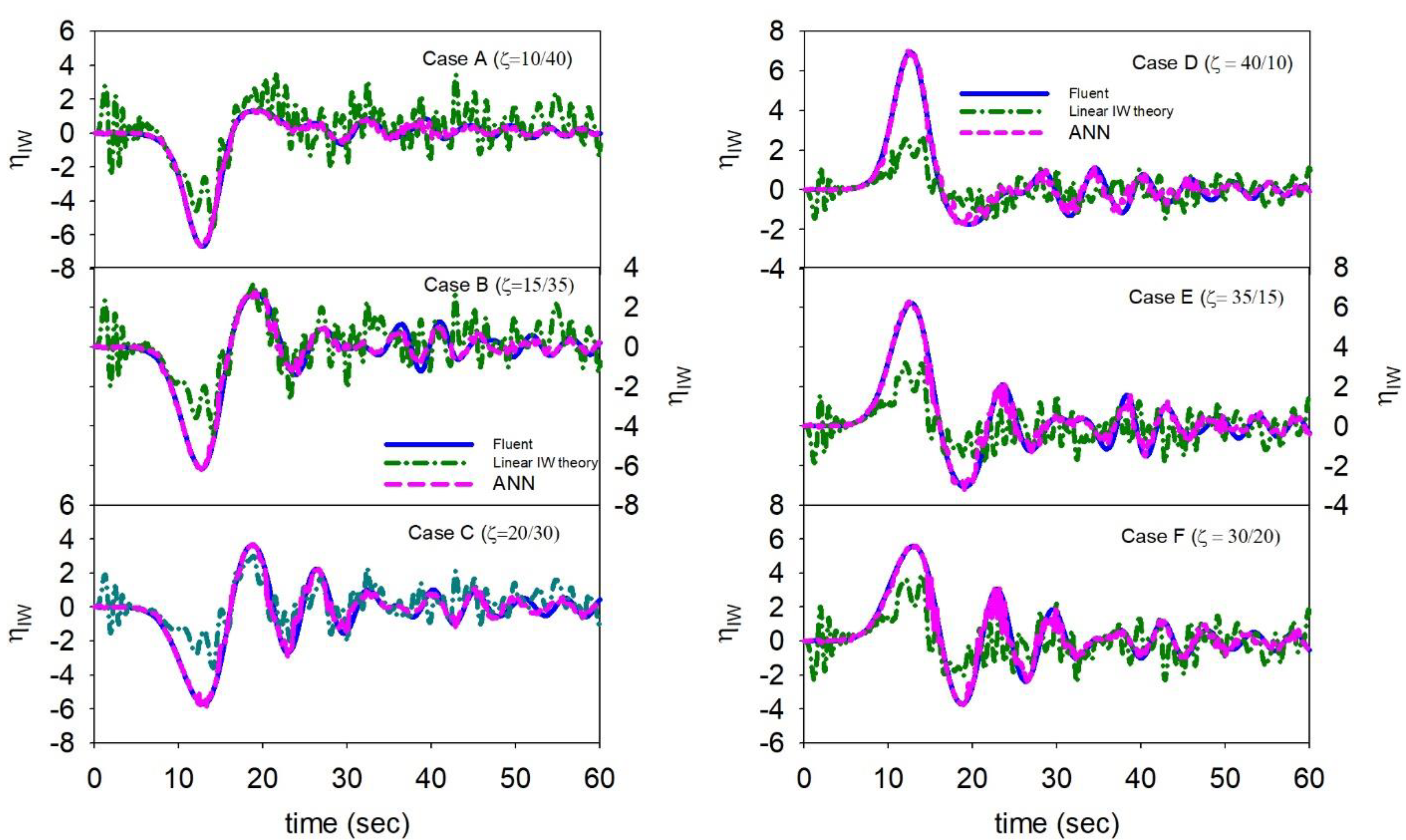
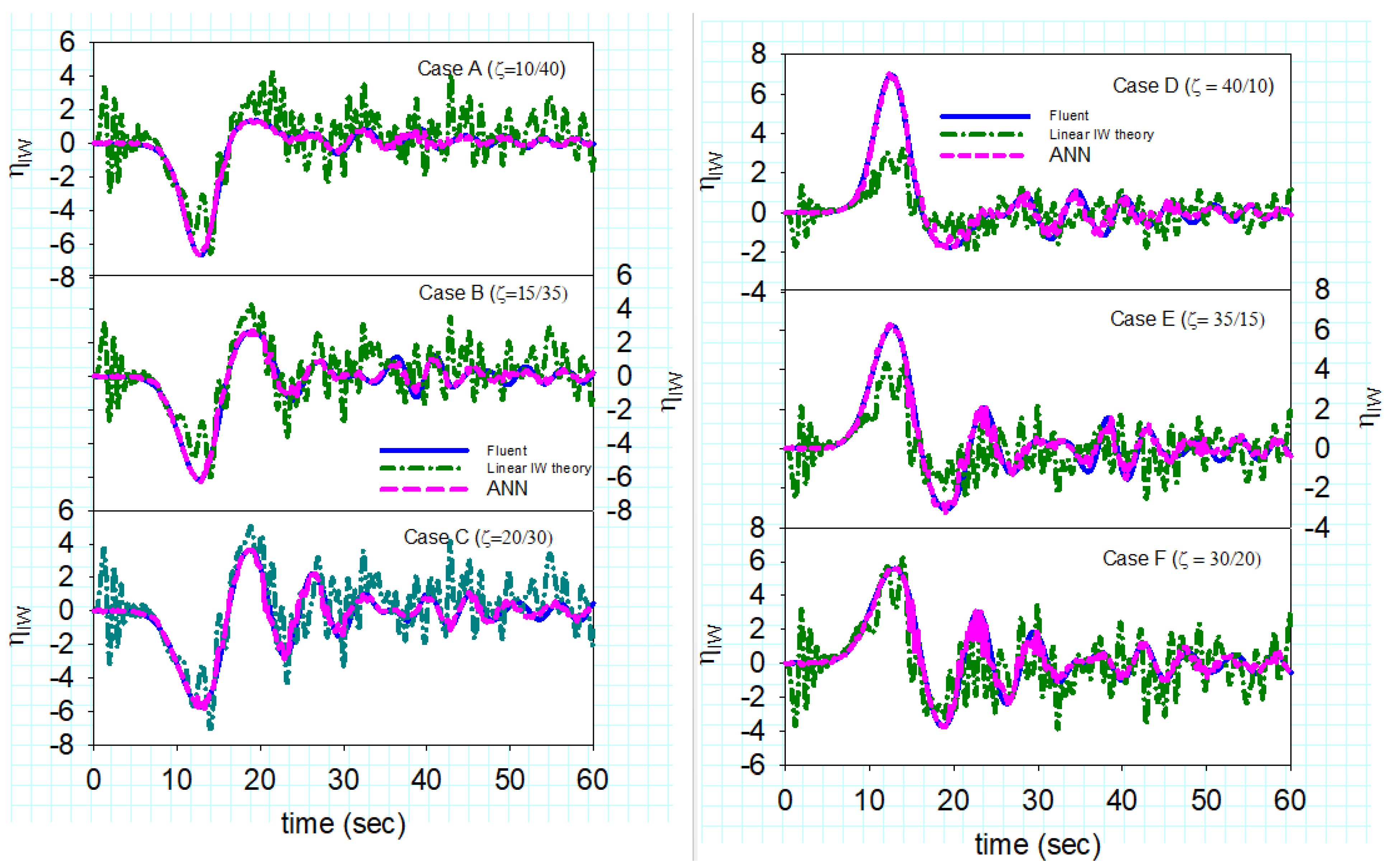
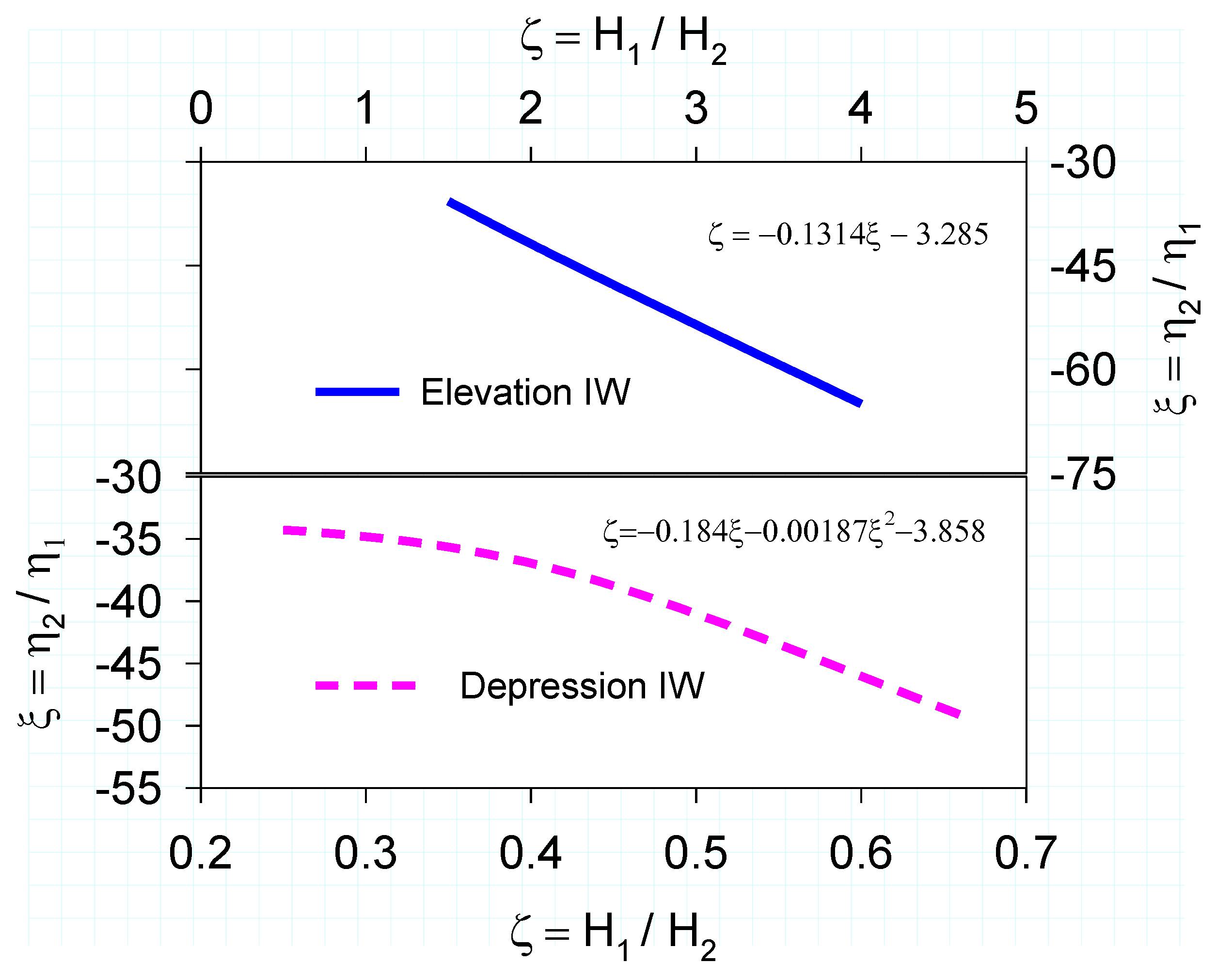
| Cases | |||
|---|---|---|---|
| Case-A | 10/40 (depression) | 15/35, 20/30, 25/35 | 5, 10, 15 |
| Case-B | 15/35 (depression) | 20/30, 25/25, 30/20 | 5, 10, 15 |
| Case-C | 20/30 (depression) | 25/25, 30/20, 35/15 | 5, 10, 15 |
| Case-D | 40/10 (elevation) | 35/15, 30/20, 25/25 | 5, 10, 15 |
| Case-E | 35/15 (elevation) | 30/20, 25/25, 20/30 | 5, 10, 15 |
| Case-F | 30/20 (elevation) | 25/25, 20/30, 15/35 | 5, 10, 15 |
| Depression Wave Cases | Elevation Wave Cases | |||
|---|---|---|---|---|
| Numbers of Hidden Layers | RMSE | R | RMSE | R |
| 25 | 0.3111 | 0.9680 | 0.4116 | 0.9480 |
| 50 | 0.2386 | 0.9813 | 0.3105 | 0.9708 |
| 100 | 0.2088 | 0.9857 | 0.2826 | 0.9758 |
| 150 | 0.2037 | 0.9864 | 0.2526 | 0.9807 |
Publisher’s Note: MDPI stays neutral with regard to jurisdictional claims in published maps and institutional affiliations. |
© 2021 by the authors. Licensee MDPI, Basel, Switzerland. This article is an open access article distributed under the terms and conditions of the Creative Commons Attribution (CC BY) license (https://creativecommons.org/licenses/by/4.0/).
Share and Cite
Chen, B.-F.; Huang, Y.-J. The Close Relationship between Internal Wave and Ocean Free Surface Wave. J. Mar. Sci. Eng. 2021, 9, 1330. https://doi.org/10.3390/jmse9121330
Chen B-F, Huang Y-J. The Close Relationship between Internal Wave and Ocean Free Surface Wave. Journal of Marine Science and Engineering. 2021; 9(12):1330. https://doi.org/10.3390/jmse9121330
Chicago/Turabian StyleChen, Bang-Fuh, and Yi-Jei Huang. 2021. "The Close Relationship between Internal Wave and Ocean Free Surface Wave" Journal of Marine Science and Engineering 9, no. 12: 1330. https://doi.org/10.3390/jmse9121330
APA StyleChen, B.-F., & Huang, Y.-J. (2021). The Close Relationship between Internal Wave and Ocean Free Surface Wave. Journal of Marine Science and Engineering, 9(12), 1330. https://doi.org/10.3390/jmse9121330






